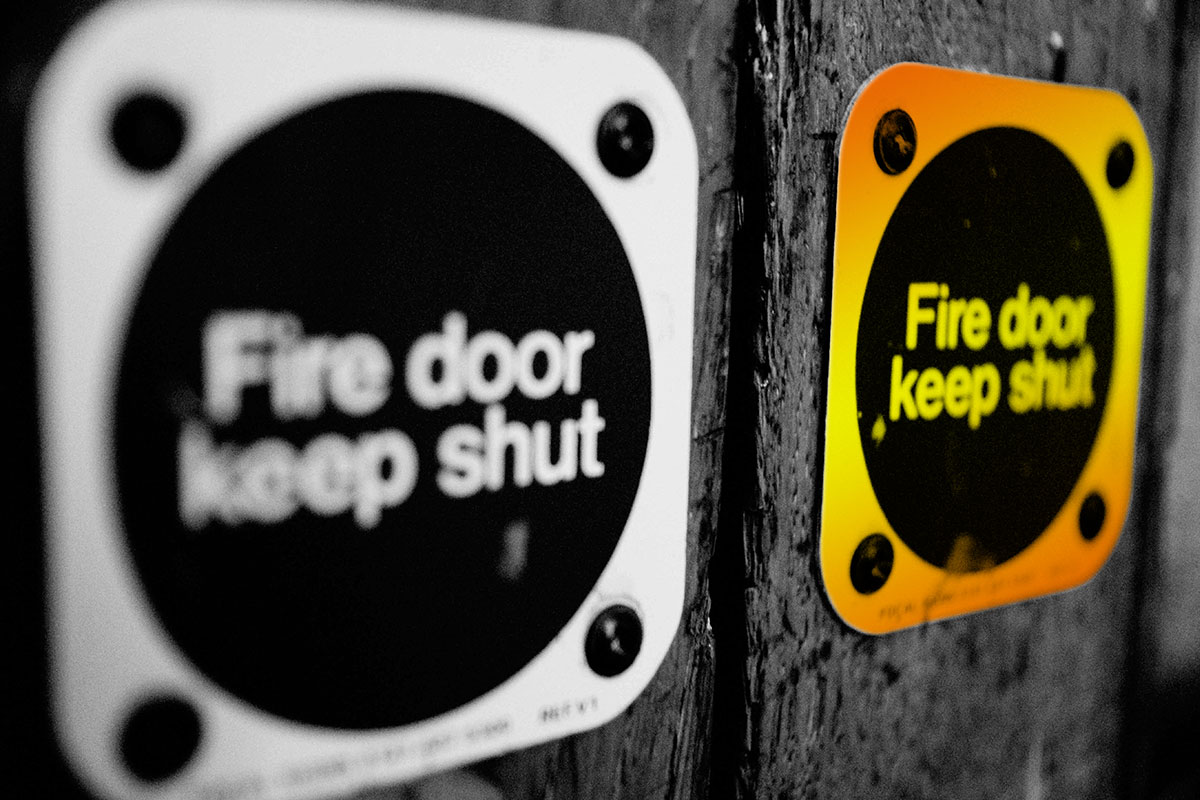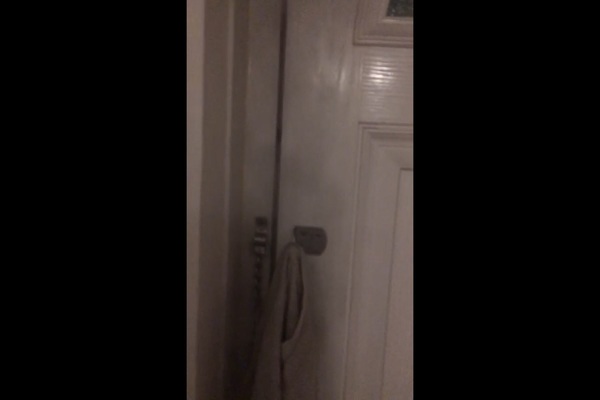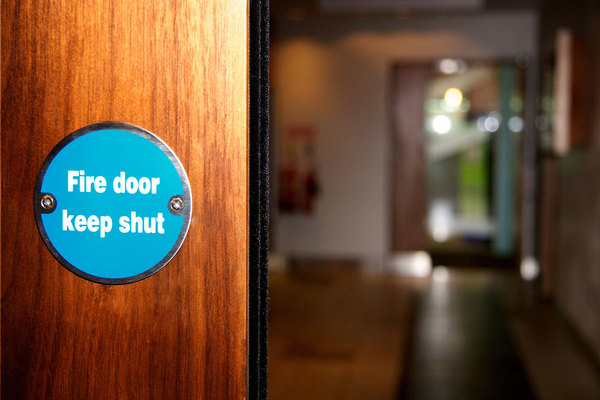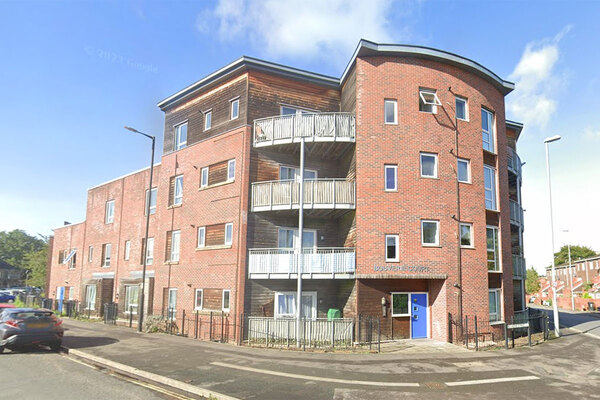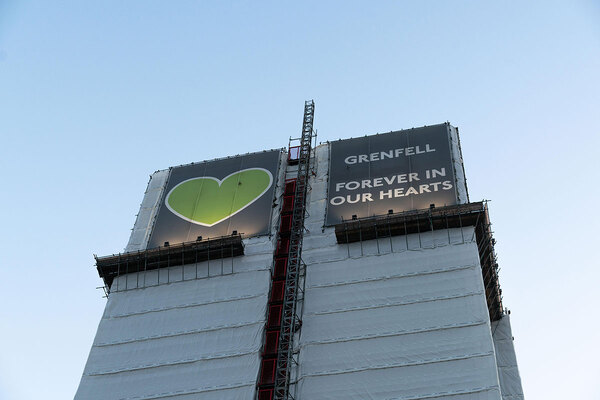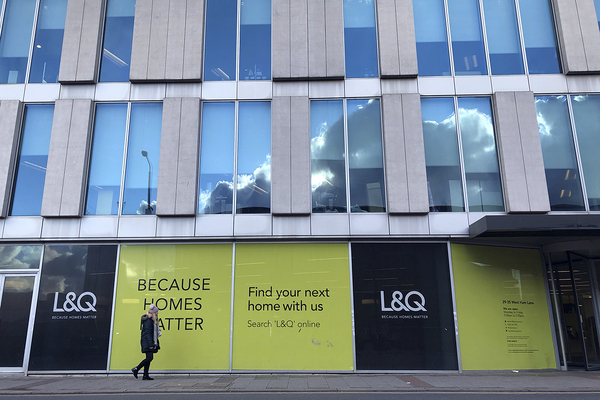You are viewing 1 of your 1 free articles
Fire door problems endemic in Grenfell Tower, survivors’ testimonies show
Broken or deficient fire doors were endemic in Grenfell Tower, an Inside Housing analysis of survivors’ statements to the inquiry has revealed.
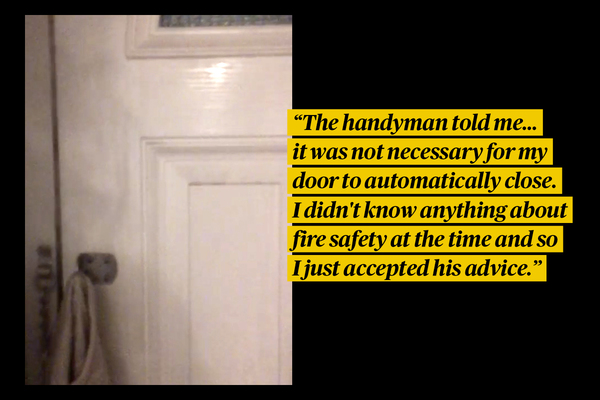
Testimonies of residents from 81 different flats in the tower show 46 of them – 56% – describe problems with fire doors, the vast majority of these referring to missing ‘self-closing’ devices.
In some cases residents report Kensington and Chelsea Tenant Management Organisation (KCTMO) actively removing self-closers after other faults were reported with the doors.
Self-closers are vital for fire safety, particularly because they protect communal areas from the smoke and flame of a fire within a flat, allowing people to escape.
At Grenfell, many residents were trapped in their homes when the single staircase filled up with smoke, and many others died on the stairs trying to flee.
Residents have also described fire doors quickly being penetrated by smoke on the night of the fire (pictured above).
Inside Housing’s analysis reveals 29 of the 81 had problems with the new windows fitted during the refurbishment – including experiencing drafts. The inquiry is investigating whether the new windows allowed fire from the cladding in and out of the flats.
The analysis also shows at least 29 complained to KCTMO or contractor Rydon, which was responsible for fitting the windows but not the fire doors, about one or both of these issues.
Emma Dent Coad, the Labour MP for Kensington where Grenfell is located, said: “These findings put numbers on the culture of disrespect for tenants that we all knew about. They represent 29 missed chances to save lives on the night of 14 June.”
Representatives of KCTMO and the Royal Borough of Kensington and Chelsea are due to appear before the inquiry for the first time today.
Most of Grenfell Tower’s wooden fire doors were replaced with plastic composite models in 2012/13. In March, the police revealed a sample door had failed to meet the minimum standards set by building guidance.
Neil Ashdown, a fire door expert, said: “If the flat entrance doesn’t close automatically then when people leave the flat to escape the fire the door is likely to stay open behind them. And so that means there’s no resistance at all there and the common areas would quickly become untenable, making it very difficult for other people to escape.”
Hanan Wahabi, who lived on the ninth floor, told the inquiry her self-closer broke shortly after the door was installed meaning the door would not close at all.
“They removed the pole entirely rather than fixing it, so my door never closed automatically,” she said. “I called KCTMO back to complain but my door was never fixed.”
Hoang Khanh Quang, who lived on the 10th floor, said a handyman attended after he reported the self-closer broken.
He added: “The handyman told me that there were other front doors in the tower which also did not automatically close and the tenants didn’t mind it. He told me that it was not necessary for my door to automatically close. I didn’t know anything about fire safety at the time and so I just accepted his advice. I thought he was the expert. From this date onwards, my front door did not automatically shut and I would have to close it myself.”
In his evidence, Edward Daffarn – a prominent campaigner and author of the Grenfell Action Group blog – who lived on the 16th floor said he reported a fire door on his floor standing open.
But he then received an email from KCTMO which said on its inspection it was able to close it.
He said this suggested the TMO “failed to action the fact that the front door to flat 136 was not self-closing when it should have been”.
On windows, many residents said they experienced cold drafts coming in through gaps after new windows were fitted in the refurbishment which was completed in 2016.
Michael Sobieszczak, who lived on the seventh floor, said he could see gaps between the window and the building which were covered with plastic. He said: “After the job was finished I could feel the draft from the window on a windy day. It seemed to be a little bit of a cowboy job.”
Marcio Gomes, who lived on floor 21, added: “The fact that the new window frames were smaller than the previous window frames resulted in substantial gaps being left around the edges of the window and underneath the window ledge. These gaps were filled with mastic and some sort of a foam-type substance.”
The windows are a crucial line of investigation for the inquiry in establishing how the fire broke out of the kitchen on the fourth floor and ignited the cladding, and how it was able to enter back into people’s homes.
Many residents have described seeing the flames enter their homes through the windows. An expert report by Dr Barbara Lane for the inquiry identified “multiple ways” fire could have broken through the windows due to combustible materials used and cavity gaps.
The Grenfell Tower Inquiry
Closing statements
Day 85: victims' lawyers attack the fire brigade
Further expert evidence
Including some additional evidence from emergency call handlers, bereaved and relatives
Day 84: further evidence from survivors and relatives
Day 83: swift evacuation of tower possible if residents alerted
Day 82: initial fire was extinguished but then returned to the flat
Day 81: overheating fridge-freezer most likely cause of fire
Day 80: fire doors installed did not match product tested
Day 79: resident advised to stay put despite fire in flat
Day 78: insulation and cladding material below required standard
Day 77: molten plastic spread blaze down tower
Day 76: 'stay put' should be dropped when fire spreads across floors
Other witness evidence
Police, ambulance, gas suppliers, council, TMO and call room operators give evidence
Day 75: call room operators give evidence
Day 74: further evidence from TMO officers
Day 73: TMO boss failed to pass information to firefighters
Day 72: fire finally extinguished when gas switched off
Day 71: further questions over stay put advice
Day 70: the police evidence
The bereaved, survivors and relatives’ evidence
Day 69: video shows smoke billowing through fire door
Day 68: KCTMO removed self closing mechanism and never replaced it
Day 67: gaps in cladding fixed with duct tape
Day 66: 'don't fix broken system with a sticking plaster'
Day 65: survivor dragged disabled man down nine floors to safety
Day 64: KCTMO 'did not replace broken fire door'
Day 63: foam insulation inside cladding 'exposed' says survivor
Day 62: father gives harrowing account of son's death
Day 61: council’s management organisation slammed for faulty electrics
Day 60: stay put advice ‘led to deaths’, residents say
Day 59: residents describe problems with new windows
Day 58: survivor describes how daughter saved his life
Day 57: firefighter evidence ‘a slap in the face’, says survivor
Day 56: relations with contractor were ‘toxic’
Day 55: resident 'never happy' with stay-put advice
Day 54: tenant gives evidence about housing association
Day 53: stay put advice 'felt like trap'
Day 52: resident saved by son's phone call
The firefighters’ evidence
Day 51: firefighter feared encouraging residents to jump
Day 50: the LFB commissioner
Day 49: fire chief reveals frustration over lack of building plans
Day 48: internal fire spread 'bigger story' than cladding
Day 47: fire officer considered evacuating crews over building collapse fears
Day 46: 'we were improvising' senior firefighter admits
Day 45: firefighter urged for abandonment of 'stay put' policy
Day 44: firefighter recalls radio signal difficulties
Day 43: call hander 'uncomfortable' with insisting residents stay put
Day 42: residents only told to leave if they called fire brigade back
Day 41: breathing equipment delay 'hampered rescues on upper floors'
Day 40: chiefs told firefighters to abandon policy
Day 39: firefighters reveal dramatic rescue of children
Day 38: firefighters issue aplogies to families
Day 37: council 'unable to provide tower plans'
Day 36: QC defends inquiry process
Day 35: Javid would welcome interim recommendations
Day 34: water from hose 'too weak' to reach the flames
Day 33: 'oh my god, we've been telling people to stay put'
Day 32: further fire fighter describes lack of equipment and low water pressure
Day 31: 'incredibly difficult' task of recording information outlined
Day 30: struggle to maintain control over rescue operation described
Day 29: fire service 'overwhelmed' by survival guidance calls
Day 28: 'the building beat us'
Day 27: firefighters 'forced to abandon plans to reach roof'
Day 26: poor signage hindered rescue efforts
Day 25: water pressure left firefighting equipment 'like garden hose'
Day 24: decision to abandon 'stay put' explored
Day 23: TV images 'could have assissted' rescue effort
Day 22: description of hectic scenes in the control centre
Day 21: account from the fire service 'nerve centre'
Day 20: firefighter describes 'huge volume' of calls from trapped residents
Day 19: firefighter 'given no training on cladding fires'
Day 18: evacuation would have been 'huge catastrophe'
Day 17: firefighters describe access and lift issues
Day 16: scenes of carnage likened to 9/11
Day 15: firefighters recount trauma of survival guidance calls
Day 14: firefighters describe spread of blaze
Day 13: firefighters recall radio difficulties
Day 12: "it was like a war zone"
Day 11: questions raised over fire fighters' radios
Day 10: watch manager emotional under questioning
Day nine: lead firefighter 'not trained in stay put policy'
The expert reports: authors give evidence to inquiry
Day eight: where the fire started
Day seven: what was in the cladding?
Day six: the cause and spread of the fire
Day five: expert highlights key issues
Day four: firefighters defend response to fire
Day three: council and contractors appear for the first time
Day two: lawyers for the survivors make their case
Day one: expert evidence released on cladding and stay put
The commemoration hearings
30 May: Grenfell Council 'recognised it should not house disabled victim above four storeys'
29 May: Anger on day six of the Grenfell Inquiry
25 May: Grenfell families 'forced to live in chimney with stay put policy'
24 May: Grenfell family complained about father being housed on 17th floor
23 May: Tributes to children on third day of Grenfell hearings
22 May: Emotions run high as Grenfell bereaved shown footage of the tower burning
21 May: Grenfell victims share tributes as inquiry opens
Never Again campaign
In the days following the Grenfell Tower fire on 14 June 2017, Inside Housing launched the Never Again campaign to call for immediate action to implement the learning from the Lakanal House fire, and a commitment to act – without delay – on learning from the Grenfell Tower tragedy as it becomes available.
One year on, we have extended the campaign asks in the light of information that has emerged since.
Here are our updated asks:
GOVERNMENT
- Act on the recommendations from Dame Judith Hackitt’s review of building regulations to tower blocks of 18m and higher. Commit to producing a timetable for implementation by autumn 2018, setting out how recommendations that don’t require legislative change can be taken forward without delay
- Follow through on commitments to fully ban combustible materials on high-rise buildings
- Unequivocally ban desktop studies
- Review recommendations and advice given to ministers after the Lakanal House fire and implement necessary changes
- Publish details of all tower blocks with dangerous cladding, insulation and/or external panels and commit to a timeline for remedial works. Provide necessary guidance to landlords to ensure that removal work can begin on all affected private and social residential blocks by the end of 2018. Complete quarterly follow-up checks to ensure that remedial work is completed to the required standard. Checks should not cease until all work is completed.
- Stand by the prime minister’s commitment to fully fund the removal of dangerous cladding
- Fund the retrofitting of sprinkler systems in all tower blocks across the UK (except where there are specific structural reasons not to do so)
- Explore options for requiring remedial works on affected private sector residential tower blocks
LOCAL GOVERNMENT
- Take immediate action to identify privately owned residential tower blocks so that cladding and external panels can be checked
LANDLORDS
- Publish details of the combinations of insulations and cladding materials for all high rise blocks
- Commit to ensuring that removal work begins on all blocks with dangerous materials by the end of 2018 upon receipt of guidance from government
- Publish current fire risk assessments for all high rise blocks (the Information Commissioner has required councils to publish and recommended that housing associations should do the same). Work with peers to share learning from assessments and improve and clarify the risk assessment model.
- Commit to renewing assessments annually and after major repair or cladding work is carried out. Ensure assessments consider the external features of blocks. Always use an appropriate, qualified expert to conduct assessments.
- Review and update evacuation policies and ‘stay put’ advice in the light of risk assessments, and communicate clearly to residents
- Adopt Dame Judith Hackitt’s recommended approach for listening to and addressing tenants’ concerns, with immediate effect
CURRENT SIGNATORIES:
- Chartered Institute of Housing
- G15
- National Federation of ALMOs
- National Housing Federation
- Placeshapers
